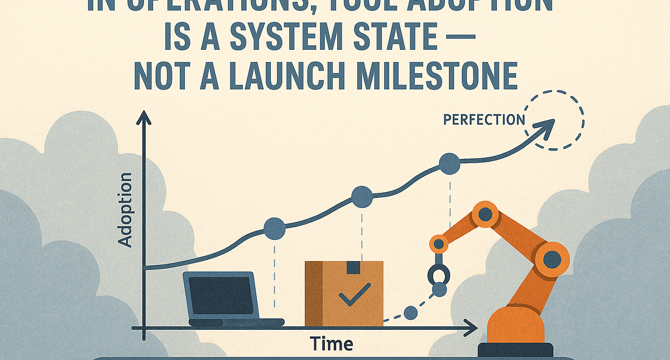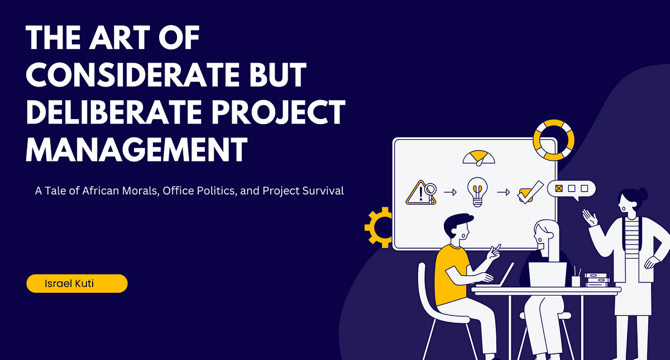Product Management News
Medium
26

Image Credit: Medium
In Operations, Tool Adoption Is a System State — Not a Launch Milestone
- In operational settings, deploying a tool doesn’t guarantee impact; results stem from continuous adoption aligned with the tool's intent.
- Product thinking in physical, distributed environments demands a focus on getting things done over delight or stickiness.
- Operational PMs must ensure tools are used as intended and still deliver the required outcomes, addressing usage divergences promptly.
- Designing for behavior in operational contexts is essential, considering factors like time pressure and varying user experience levels.
- Op-tech challenges involve building systems that triangulate truth amidst noise, bias, and human inconsistency.
- Product design should aim to improve outcomes through clear mechanisms, coaching, and system enhancements.
- Forecast overrides and computer vision-based solutions exemplify the need for high-confidence input and system integrity in operations.
- Alignment across stakeholders and persistent product leadership are crucial for maintaining tool effectiveness and performance over time.
- Product thinking is essential throughout the life cycle of operational systems to prevent adoption drift and ensure sustained success.
- The article emphasizes the importance of product leadership in operational domains for continued tool usage and system effectiveness.
Read Full Article
1 Like
Medium
272

The Invisible PM Skill That Makes Great Products Irresistible
- Flow is essential in keeping users engaged with a product, making it feel intuitive and seamless.
- Product design should focus on anticipating user needs and guiding them towards their goals effortlessly.
- Emphasizing flow over flashy features can lead to a more satisfying user experience.
- Product managers should prioritize smoothing out the user's journey through the product.
- Incorporating invisible wins and removing obstacles can enhance the overall product experience.
- AI can either enhance or hinder flow within a product, depending on how it is integrated.
- The best products don't feel like tools; they facilitate tasks with minimal friction and maximum confidence.
- Successful product management involves prioritizing user flow over mere feature implementation.
- Focusing on flow can elevate a product from ordinary to extraordinary.
- It's crucial for product managers to consider how their decisions impact the user's experience and the seamless flow within the product.
Read Full Article
16 Likes
Medium
333
Image Credit: Medium
The People-First Design Advantage: Why Companies That Care About Designers Outperform Those That…
- The tech industry faces a design talent crisis caused by toxic work environments.
- Companies treating designers as strategic partners outperform others in growth and innovation.
- Design-focused companies show better business outcomes and financial benefits.
- Airbnb's success is attributed to empowering designers as strategic decision-makers.
- Established companies often overlook digital design, leading to ineffective outcomes.
- Design is often treated as an afterthought, resulting in costly fixes and technical debt.
- People-first companies integrate design thinking into core decision-making processes.
- Designers prefer companies valuing their strategic contributions and offering growth opportunities.
- Design-forward companies attract top designers with culture and growth prospects.
- Companies embedding design thinking in their DNA outperform competitors in user-centric markets.
- The choice is between short-term cost optimization and long-term competitive advantage.
- Companies must invest in people-first design culture to stay competitive.
- Designers are crucial in shaping a company's competitive future.
- User expectations drive the importance of design culture in product development.
- Companies need to view design as a strategic investment, not just a cost center.
Read Full Article
19 Likes
The Beautiful Mess
242

Image Credit: The Beautiful Mess
TBM 362: How (And Why) We Help
- The article discusses the impact of different consulting approaches on personal well-being and organizational change.
- It contrasts the traditional consulting model, focusing on gaps and expert guidance, with a more relational approach advocating for client empowerment and self-directed change.
- Peter Block's model emphasizes building clients' capacity and challenging traditional frames, promoting reflection and shared ownership.
- The article explores the tensions between adhering to the dominant consulting narrative and advocating for alternative, more inclusive methodologies.
- It delves into the importance of context, dialogue, and emergence in facilitating meaningful change within organizations.
- The author reflects on personal experiences and emotional responses within complex systems and discusses the need for self-awareness and authenticity in professional interactions.
- Overall, the article encourages readers to consider their roles within organizational dynamics and to approach their work consciously and responsibly.
Read Full Article
11 Likes
Discover more
- Programming News
- Software News
- Web Design
- Devops News
- Open Source News
- Databases
- Cloud News
- Operating Systems News
- Agile Methodology News
- Computer Engineering
- Startup News
- Cryptocurrency News
- Technology News
- Blockchain News
- Data Science News
- AR News
- Apple News
- Cyber Security News
- Leadership News
- Gaming News
- Automobiles News
Medium
147

Image Credit: Medium
RFI Volume Is Rising — and So Is Its Complexity
- Regulatory requests for information (RFIs) are increasing in frequency, complexity, and scope, with regulators expecting detailed explanations, structured narratives, and cross-team coordination.
- Organizations facing RFIs are struggling with manual tools and processes, leading to rushed and inconsistent responses, increasing operational and risk burdens.
- Addressing the RFI challenges requires automation with legal oversight to handle tasks such as documentation retrieval, task allocation, and initial response generation.
- Automation can significantly reduce search time, improve accuracy, prevent bottlenecks, and ensure accountability in the RFI workflow.
- Human-in-the-loop design is crucial in legal contexts to maintain trust, with AI outputs always passing through expert review and validation gates.
- Ensuring consistency across RFIs over time and regulators is a key goal, where structured automation creates a reliable reference set for validation.
- RFI systems need to be treated as core legal infrastructure, with structured response infrastructure, automation, version control, and audit capabilities becoming essential.
- AI in RFIs aims to streamline processes, enhance decision-making, and improve outcomes, but judgment and human oversight remain irreplaceable.
Read Full Article
8 Likes
Medium
297

Image Credit: Medium
Product Requirements Document (PRD) for Rapid Sleep App
- The Rapid Sleep App aims to help users fall asleep quickly and experience a full rest cycle in 1/10th of the usual time.
- Target audience includes busy professionals, students, parents, and those seeking to maximize time without compromising sleep quality.
- User benefits comprise quick induction into deep sleep, feeling refreshed upon waking, and more waking hours for productivity or leisure.
- Key insights reveal an increasing need for efficient sleep solutions due to busy lifestyles.
- Existing solutions mainly focus on aiding faster sleep onset but not necessarily shortening sleep duration.
- Differentiation lies in employing neuroscience techniques, integrating with health trackers, and personalizing the sleep experience.
- Efficient sleep is vital for health and productivity, with the app potentially revolutionizing sleep management.
- The PRD outlines the app's innovative approach to improving users' sleep quality and overall well-being.
- The app merges technology and user-centric design to optimize sleep patterns with efficiency.
- The app stands out by enabling full rest in less time, promising enhanced life quality and productivity.
- The app represents innovation in sleep technology, potentially transforming how sleep is approached and managed.
- The eligibility for web story should be determined based on the uniqueness of the concept and its potential impact.
- The course links provided at the end are extraneous and unrelated to the content of the PRD.
- The emphasis is on addressing the common challenge of sleep deprivation with a novel approach.
- The app's integration with health tracking devices enhances the user experience and effectiveness.
- Innovations in sleep science are at the core of the app's development, highlighting a commitment to enhancing user well-being.
Read Full Article
17 Likes
Medium
102

Image Credit: Medium
Product Requirements Document (PRD) for an Alarm Clock App— An Example
- Developing an alarm clock app to improve time management and well-being by offering a personalized wake-up experience and integration with productivity tools.
- User benefits include customizable alarms, wake-up challenges, sleep analysis, and integration with calendars and task management tools.
- Providing advanced features like smart wake-up algorithms, health app integration, and gamified challenges for user engagement.
- Monitoring metrics like user adoption rate, engagement, retention, customer satisfaction, and sleep quality improvement reports for success evaluation.
- Targeting working professionals, students, and those seeking disciplined sleep schedules with a focus on enhancing daily productivity and health.
- The PRD aims to redefine morning routines by addressing existing app limitations and focusing on user-centric features for a more engaging wake-up experience.
- Elements like integration with other tools, improved sleep patterns, user engagement, and health contribution are central to the app's differentiation and success.
- Leveraging the latest app technology to provide a superior user experience and meet the market's demand for well-being-focused alarm clock solutions.
- Tracking metrics such as market penetration, competitiveness, revenue, and integration usage statistics to ensure continuous improvement and user satisfaction.
- Regular analysis of both quantitative and qualitative metrics will guide ongoing product development and marketing strategies for the app's evolution.
Read Full Article
6 Likes
Medium
196

Image Credit: Medium
The Art of Considerate but Deliberate Project Management: A Tale of African Morals, Office…
- In Nigeria, project managers often struggle with escalating issues with unresponsive client representatives due to cultural values of seniority and respect.
- Avoiding necessary escalations can jeopardize the project's success as delays mount and pressure on the team increases.
- A project manager in Nigeria handling a project for a leading bank faced delays from a client's staff member responsible for approvals despite various attempts to prompt responses.
- Instead of direct escalation, the project manager implemented a structured approach of sending weekly status reports as an insurance policy in case of project delays.
- Project management requires a blend of cultural intelligence, emotional intelligence, and strategic decision-making to balance relationships with project success.
- Prioritizing relationships over project delivery can lead to missed deadlines, financial losses, and tarnished reputations in the Nigerian business environment.
- It is crucial for project managers to find the right balance between being considerate and deliberate in their actions to ensure project success.
- Key question for project managers: Are relationships being prioritized over project delivery at the cost of project success?
- Being more deliberate while remaining diplomatic is essential to succeed in the Nigerian business landscape.
- Project managers in Nigeria must navigate cultural values while ensuring project success through effective communication and decision-making.
- Balancing stakeholder relationships and project objectives is critical in managing projects successfully in Nigeria.
- Cultivating habits like sending weekly status reports can help project managers navigate challenges and protect their companies from undue blame.
- The story illustrates the importance of effectively managing project stakeholders while maintaining a focus on project outcomes.
- Project managers need to consider both relational and task-oriented aspects to ensure successful project delivery in diverse cultural contexts.
- Building trust, communicating effectively, and making strategic decisions are essential components of successful project management.
- The project management approach described emphasizes the need for project managers to be intentional and diplomatic in their interactions for project success.
Read Full Article
11 Likes
UX Design
228
Image Credit: UX Design
How jam jars explain Apple’s success
- The article discusses how brands like Apple achieve success by offering fewer, well-presented choices to consumers, based on behavioral psychology and product design.
- A study on the Paradox of Choice by Iyengar and Lepper showed that more options can lead to decision paralysis and decreased satisfaction.
- Contrary findings by Scheibehenne raised questions if it's choice overload or information overload affecting satisfaction.
- The author conducted a study using an e-commerce dataset supporting that more choices do not equate to higher satisfaction levels.
- Apple's success is attributed to simplifying product lines and offering confident defaults for consumers, enhancing decision-making experiences.
- Factors like time pressure and clarity of preference influence consumer choices, as found in a 2015 study.
- The article emphasizes the importance of curating choices effectively to avoid decision fatigue and enhance customer satisfaction.
- Common mistakes in product offerings, such as too many choices and lack of clear labels, are highlighted with solutions using the 'Jam Jar strategy.'
- The key takeaway is to provide consumers with clear, easy-to-understand choices to streamline decision-making processes effectively.
Read Full Article
13 Likes
Medium
117

Image Credit: Medium
How How Artificial Intelligence Will Change the Finance Industries
- AI is changing the finance industry by improving client services and operational efficiencies.
- Bank of America's AI 'Erica' has facilitated over 1.5 billion interactive experiences through its banking app.
- AI in banking enables interactive conversations, automation of processes like loan approvals and credit scoring, reducing time and potential human error.
- AI systems in banking also assess customer behaviors and provide recommendations for financial behaviors like budgeting or investing.
- The investing and wealth management sectors have experienced a digital transformation with the rise of robo advisors using machine learning algorithms.
- Robo advisors are projected to reach over $2 trillion in global assets under management by 2027, offering low-cost personalized portfolio management.
- AI allows institutional investors to analyze large amounts of market data, news articles, and sentiment simultaneously, improving decision-making efficiency.
- AI plays a crucial role in fraud prevention by identifying normal and suspicious behaviors rapidly, reducing fraud loss and false positives.
- AI-powered fraud detection systems have shown detection rates 50% higher than traditional systems, aiding institutions in compliance with regulations.
- Financial professionals need to consider risks such as algorithmic bias, privacy data reliability, and governance frameworks as AI roles evolve.
- Despite risks, AI is expected to create a more secure, responsive, and inclusive financial ecosystem for both institutions and individuals.
Read Full Article
7 Likes
Medium
205

Image Credit: Medium
The Product Manager’s Ultimate Dilemma: Why MVP vs MDP Could Make or Break Your 2025 Strategy
- The choice between MVP and MDP in product management in 2025 is crucial for survival, with implications for market demand and success.
- Both approaches offer benefits: MVP for speed and cost efficiency, and MDP for superior user experience and brand loyalty.
- Successful companies blend MVP and MDP strategies for market momentum, as seen in examples like Dropbox and Headspace.
- MVP is ideal for testing new concepts quickly under limited resources and in rapidly changing markets.
- MDP excels in competitive markets where user experience drives product effectiveness and brand reputation is crucial.
- The Core-Experience Matrix guides product managers to balance MVP speed with MDP quality for sustainable success.
- AI tools and customer advisory boards are aiding in faster development and informed decision-making in product management.
- Considerations for choosing between MVP and MDP include market risk, competitive context, user emotional state, resource availability, and success timeline.
- The new success formula combines MVP problem discovery with MDP solution execution for sustainable product success.
- Hybrid approaches that prioritize problem-solution fit and user experience quality are key to product success in 2025.
- The article provides a framework and steps for product managers to navigate the MVP vs MDP decision effectively in their product strategy.
Read Full Article
12 Likes
Medium
237

Image Credit: Medium
The New Creative Supply Chain: A Game Plan for AI Content
- The article discusses the AI-Powered Creative Supply Chain involving people, technology, and processes working together for content creation and improvement in a systematic and scalable manner.
- It highlights the shift towards AI-assisted brainstorming, fast prototyping, personalizing content at scale, and automated distribution resulting in significant speed and efficiency improvements.
- Emphasizes that human creativity remains crucial, with individuals transitioning to higher-level roles like strategy setting and ethical oversight while leveraging AI tools efficiently.
- Addresses the importance of AI Model Strategy, Data Governance, and Ethical Oversight in managing AI content production effectively.
- Highlights the need for Product Managers to develop a mix of strategic thinking, technical understanding, and data analysis skills to orchestrate the AI content lifecycle successfully.
- Provides a five-pillar guide focusing on strategy alignment, tech management, creative inputs control, quality & ethics, and performance measurement for AI content projects.
- Points out the economic potential of AI in marketing and productivity gains demonstrated by AI tools in enhancing content creation processes.
- Stresses the critical role of Product Managers in navigating the AI-driven Creative Supply Chain to create valuable customer experiences while aligning human creativity, AI, and business goals effectively.
- The article concludes by presenting a significant economic impact estimation of GenAI and underscores the opportunity and challenge for Product Managers to shape the future of creative content.
Read Full Article
14 Likes
Medium
201

Image Credit: Medium
How to Assess Product-Market Fit (PMF) in a Web3 Product
- Product-market fit in Web3 is often misrepresented, focusing on behavioral dependency.
- PMF starts with solving real, ongoing, painful problems for specific user groups.
- Building for a small, high-frequency user group with an atomic network is crucial for PMF.
- PMF is when users can't live without the product, not just having a high number of users.
- Retention and user behavior without incentives are key indicators of PMF.
- Users should demonstrate emotional engagement and integrate the product into their workflow for PMF.
- User obsession and frustration are stronger signals than praise for PMF.
- Tokens should amplify behavior, not be the primary driver; PMF should persist through bear markets.
- Assess PMF under pressure, looking at sustained usage across different market cycles.
- True utility in Web3 is rare, making achieving PMF essential for a product's survival.
Read Full Article
12 Likes
Medium
156
Image Credit: Medium
Rethinking Zomato: Turning Sellers into Growth Partners
- Zomato is rethinking its strategy to increase revenue by evolving its business model to benefit both Zomato and its sellers.
- Zomato's consumer growth in urban areas has plateaued, facing competition from Swiggy, Ola Foods, and ONDC.
- A focus shift is needed from increasing app installs to creating a model that fosters growth for both Zomato and sellers.
- Zomato's seller ecosystem, especially medium AOV cloud kitchens, has potential for a new model allowing stable demand and revenue growth.
- Medium-scale events present opportunities for cloud kitchens to increase brand recognition and secure new customers outside of standard delivery.
- The proposed model benefits Zomato, sellers, and consumers by providing stable demand, revenue growth, and new customer acquisition channels.
- This new perspective sees Zomato as a B2B platform for food entrepreneurs, aiming to support the growth of cloud kitchens with diverse revenue streams.
- The future of food tech may involve innovative behind-the-scenes business models, with platforms like Zomato taking a leading role.
Read Full Article
9 Likes
Medium
322

Image Credit: Medium
Rapid prototyping with v0.Dev a hands-on Guide for PMs
- v0.Dev allows Product Managers to build high-fidelity prototypes quickly without designer involvement.
- The tool generates developer-ready prototypes in under 10 minutes using AI, enabling faster communication of product ideas.
- v0.Dev and similar tools like Lovable focus on creating actionable UI based on familiar design systems, eliminating design bottlenecks.
- Product Managers can maintain creative control while producing polished prototypes aligned with existing design language.
- Manually inputting prompts into v0.Dev ensures tailored and accurate prototypes that address real product problems effectively.
- The tool generates interactive wireframes with event triggers, facilitating quick testing and updates.
- v0.Dev complements the Product Requirements Document (PRD) by providing powerful visual aids but is not a replacement for it.
- An upcoming event by v0.Dev on June 25th is mentioned in the post.
Read Full Article
19 Likes
For uninterrupted reading, download the app